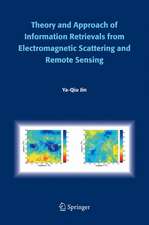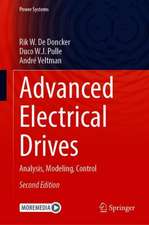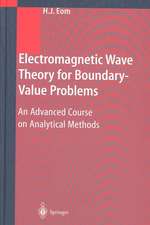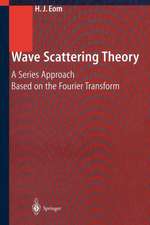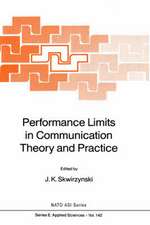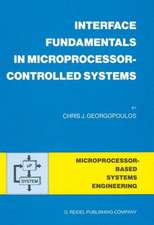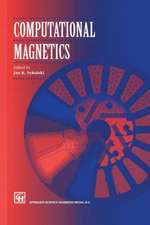Primary Theory of Electromagnetics: Power Systems
Autor Hyo J. Eomen Limba Engleză Paperback – 27 aug 2016
| Toate formatele și edițiile | Preț | Express |
|---|---|---|
| Paperback (1) | 383.50 lei 6-8 săpt. | |
| SPRINGER NETHERLANDS – 27 aug 2016 | 383.50 lei 6-8 săpt. | |
| Hardback (1) | 390.84 lei 6-8 săpt. | |
| SPRINGER NETHERLANDS – 17 sep 2013 | 390.84 lei 6-8 săpt. |
Din seria Power Systems
- 18%
 Preț: 953.13 lei
Preț: 953.13 lei - 18%
 Preț: 783.98 lei
Preț: 783.98 lei - 20%
 Preț: 1002.48 lei
Preț: 1002.48 lei - 18%
 Preț: 1021.86 lei
Preț: 1021.86 lei - 18%
 Preț: 897.65 lei
Preț: 897.65 lei - 18%
 Preț: 788.72 lei
Preț: 788.72 lei - 18%
 Preț: 734.27 lei
Preț: 734.27 lei - 18%
 Preț: 902.36 lei
Preț: 902.36 lei -
 Preț: 563.51 lei
Preț: 563.51 lei - 18%
 Preț: 955.08 lei
Preț: 955.08 lei - 18%
 Preț: 946.87 lei
Preț: 946.87 lei - 18%
 Preț: 950.52 lei
Preț: 950.52 lei - 18%
 Preț: 949.23 lei
Preț: 949.23 lei - 15%
 Preț: 641.85 lei
Preț: 641.85 lei - 18%
 Preț: 1116.26 lei
Preț: 1116.26 lei - 18%
 Preț: 961.10 lei
Preț: 961.10 lei - 18%
 Preț: 1380.78 lei
Preț: 1380.78 lei - 15%
 Preț: 639.59 lei
Preț: 639.59 lei - 15%
 Preț: 641.03 lei
Preț: 641.03 lei - 18%
 Preț: 2497.51 lei
Preț: 2497.51 lei - 18%
 Preț: 957.62 lei
Preț: 957.62 lei - 18%
 Preț: 1229.91 lei
Preț: 1229.91 lei - 15%
 Preț: 643.34 lei
Preț: 643.34 lei - 18%
 Preț: 957.09 lei
Preț: 957.09 lei - 18%
 Preț: 1231.47 lei
Preț: 1231.47 lei - 15%
 Preț: 698.30 lei
Preț: 698.30 lei - 18%
 Preț: 953.20 lei
Preț: 953.20 lei - 15%
 Preț: 640.88 lei
Preț: 640.88 lei - 15%
 Preț: 634.18 lei
Preț: 634.18 lei - 18%
 Preț: 955.08 lei
Preț: 955.08 lei - 18%
 Preț: 1241.73 lei
Preț: 1241.73 lei - 18%
 Preț: 952.09 lei
Preț: 952.09 lei - 18%
 Preț: 946.55 lei
Preț: 946.55 lei - 18%
 Preț: 961.86 lei
Preț: 961.86 lei - 18%
 Preț: 944.19 lei
Preț: 944.19 lei - 18%
 Preț: 1110.72 lei
Preț: 1110.72 lei - 15%
 Preț: 642.03 lei
Preț: 642.03 lei - 15%
 Preț: 636.12 lei
Preț: 636.12 lei - 18%
 Preț: 1054.99 lei
Preț: 1054.99 lei - 15%
 Preț: 639.90 lei
Preț: 639.90 lei - 18%
 Preț: 957.32 lei
Preț: 957.32 lei - 18%
 Preț: 1235.57 lei
Preț: 1235.57 lei - 18%
 Preț: 959.19 lei
Preț: 959.19 lei
Preț: 383.50 lei
Nou
Puncte Express: 575
Preț estimativ în valută:
73.38€ • 76.62$ • 60.60£
73.38€ • 76.62$ • 60.60£
Carte tipărită la comandă
Livrare economică 15-29 aprilie
Preluare comenzi: 021 569.72.76
Specificații
ISBN-13: 9789402400328
ISBN-10: 940240032X
Pagini: 205
Ilustrații: IX, 205 p. 148 illus.
Dimensiuni: 155 x 235 x 12 mm
Greutate: 0.31 kg
Ediția:Softcover reprint of the original 1st ed. 2013
Editura: SPRINGER NETHERLANDS
Colecția Springer
Seria Power Systems
Locul publicării:Dordrecht, Netherlands
ISBN-10: 940240032X
Pagini: 205
Ilustrații: IX, 205 p. 148 illus.
Dimensiuni: 155 x 235 x 12 mm
Greutate: 0.31 kg
Ediția:Softcover reprint of the original 1st ed. 2013
Editura: SPRINGER NETHERLANDS
Colecția Springer
Seria Power Systems
Locul publicării:Dordrecht, Netherlands
Cuprins
1 Vectors.- 2 Electrostatics.- 3 Magnetostatics.- 4 Faraday's Law of Induction.- 5 Maxwell's Equations.- 6 Uniform Plane Waves.- 7 Transmission Lines.- 8 Waveguides and Antennas.- A Symbols, Notations, and Acronyms.- B Vector Formulas.- C Gradients, Divergences, Curls, and Laplacians.- D Dirac Delta Functions.- E Answers to Problems.- Index.
Notă biografică
Hyo J. Eom received the B.S. degree in electronic engineering from Seoul National University, Seoul, Korea, in 1973, and the M.S. and Ph.D. degrees in electrical engineering from the University of Kansas, Lawrence, USA, in 1977 and 1982, respectively. From 1981 to 1984, he was a Research Associate at the Remote Sensing Laboratory, University of Kansas. From 1984 to 1989, he was with the Faculty of the Department of Electrical Engineering and Computer Science, University of Illinois, Chicago, USA. In 1989, he joined the Department of Electrical Engineering, KAIST, Daejeon, Korea, where he is now a Professor. His research interests are electromagnetic wave theory and scattering.
Textul de pe ultima copertă
This is a textbook on electromagnetics for undergraduate students in electrical engineering, information, and communications. The book contents are very compact and brief compared to other commonly known electromagnetic books for undergraduate students and emphasizes mathematical aspects of basic electromagnetic theory. The book presents basic electromagnetic theory starting from static fields to time-varying fields. Topics are divided into static electric fields, static magnetic fields, time-varying fields, and electromagnetic waves. The goal of this textbook is to lead students away from memorization, but towards a deeper understanding of formulas that are used in electromagnetic theory. Many formulas commonly used for electromagnetic analysis are mathematically derived from a few empirical laws. Physical interpretations of formulas are de-emphasized. Each important formula is framed to indicate its significance. Primary Theory of Electromagnetics shows a clear and rigorous account of formulas in a consistent manner, thus letting students understand how electromagnetic formulas are related to each other.
Caracteristici
Presents the essence of electromagnetics to students in electrical engineering Electromagnetic theory is summarized from the mathematical viewpoint Fundamental electromagnetic formulas are concisely derived Examples with detailed solution procedures are given to help students understand electromagnetic formulas



